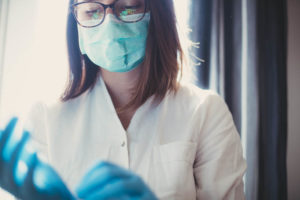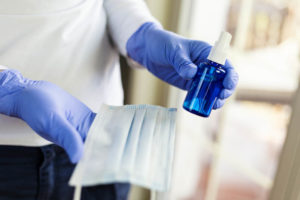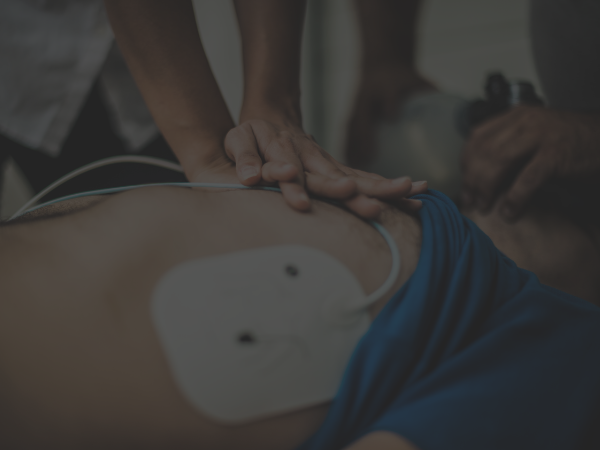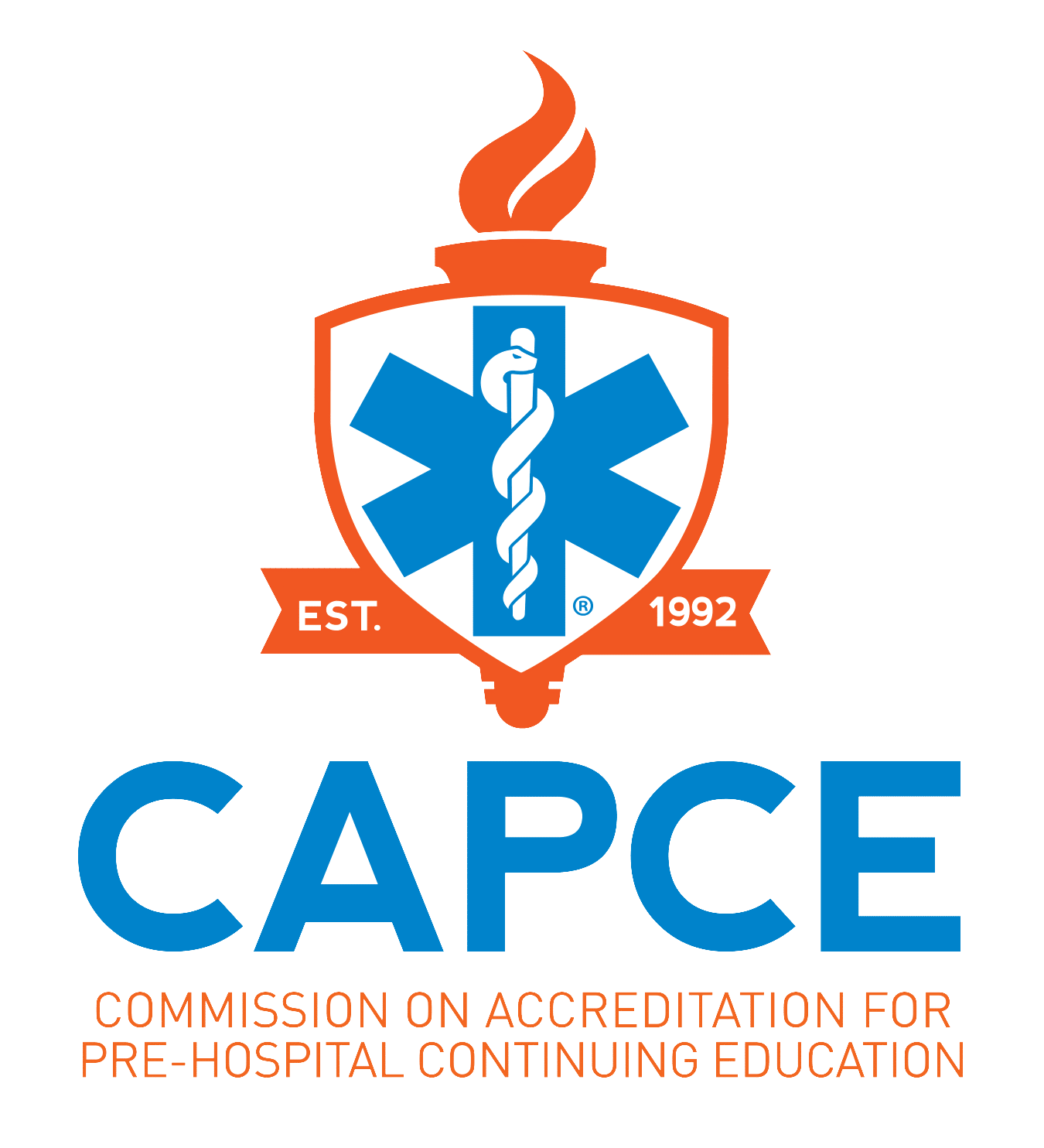Your cart is currently empty!
Basic Life Support COVID Algorithms Updated: What to Know
Most people in the US who work outside of critical care, emergency, armed services, law enforcement, and similar high-risk professions rarely expect to face a life and death situation. But if there’s one thing COVID-19 has brought to light, it’s this.
Any one of us could face a situation where we need to be a “rescuer” who provides basic life support to resuscitate and/or keep a person’s heart beating or lungs working until medical personnel can take over. The person rescued could be a loved one, a co-worker, or someone who just happened to ride the same bus you did that day.
COVID patients are especially vulnerable to cardiac arrest because, as we’ve seen, their situation can go downhill very fast. They face many breathing and heart-related complications like:
- Pneumonia (fluid on the lungs)
- Acute respiratory failure
- Dangerously high blood pressure
- Acute Respiratory Distress Syndrome (ARDS), which is when lungs are so damaged that outside fluid leaks into them, preventing enough oxygen from getting into the body.
- Blood clots
- Acute cardiac injury
Basic Life Support (BLS) training gives you some education and guidelines to preserve life, and to whatever extent possible, quality of life whether you’re a nurse, EMT, or an elementary school teacher who just wants to be prepared for the “what-if”. You’ll know what to do in common COVID-related emergencies and be able to offer first aid, CPR, and defibrillation.
Given the recentness of COVID, however, it has taken some time to get COVID algorithms updated across organizations.
COVID Algorithms Updated on the SaveaLife.com
We’re pleased to report that COVID algorithms have been updated, including:
- Adult Basic Life Support (BLS) Cardiac Arrest Algorithm for Suspected or Confirmed COVID-19 Patients
- Advanced Cardiac Life Support (ACLS) Cardiac Arrest Algorithm for Suspected or Confirmed COVID-19 Patients
- Pediatric Cardiac Arrest Algorithm for Suspected or Confirmed COVID-19 Patients
The Basic Life Support COVID algorithm is now part of Basic Life Support training, while the other two are now part of ACLS and Pediatric Advanced Life Support (PALS) training, respectively.
Even if you recently got your certification, and it’s not the time for a recertify, we hope you’ll review the latest evidence-based guidance for COVID BLS, ACLS, and PALS in the links above.
While COVID research is still ongoing, these algorithms are all in line with ilcor.org (The International Liaison Committee on Resuscitation (ILCOR)) guidance based upon their well-respected research. Through this research, they develop a Consensus on Science with Treatment Recommendations (CoSTR) to guide healthcare professionals.
Why Are Algorithms Important in Healthcare?
First of all, algorithms are best practices, backed by science, and proven to increase the chance of survival in those who experience an event such as cardiac arrest, respiratory failure, or both. It’s important to note that algorithms like these aren’t just about keeping someone alive. Maintaining quality of life is important. And often a bystander who is not a healthcare professional is the first person on the scene.
What this person does quickly and competently can preserve quality of life for the person who is experiencing an event. Keeping the heart beating and lungs filling can preserve brain function until emergency responders arrive. Algorithms show you how to do this in various situations.
Algorithms also have some added secondary benefits that can’t be denied like:
- Cutting down on the chaos because the two or more people are playing by the same playbook–an algorithm.
- Helping rescuers commit to an action more quickly when seconds matter
- Promoting calm determination when panic might otherwise take over in an unprepared individual or group
- Reducing the risk of mistakes
Algorithms also breakdown what to do into an easy-to-understand visual decision tree.
A basic life support algorithm mostly covers the Chain of Survival. You are keeping a person alive as safely as possible while awaiting emergency responders who will then take over the chain and begin more advanced life-saving measures covered in Advanced Cardiac Life Support (ACLS) training.
Why Do We Need Algorithms Specific to COVID?
 While COVID-19 science is very new and subject to change, we do know that COVID presents some unique challenges that require a specific algorithm for confirmed or suspected COVID emergencies.
While COVID-19 science is very new and subject to change, we do know that COVID presents some unique challenges that require a specific algorithm for confirmed or suspected COVID emergencies.
When people get “regular” flu, they’re only contagious about one day before symptoms. In COVID, researchers believe it may be two days, according to CDC.gov. It is also believed that they may be contagious for as many as 10 days after a positive COVID test. With the flu, it’s only seven days. The Centers for Disease Control and Prevention has also noted that COVID spreads more easily and quickly than regular flu. However, the exact transmission rate is hard to nail down even with ardent medical research.
In addition to the transmission rate, the outcome of a positive test is somewhat unpredictable. According to the CDC, some factors do correlate to severe outcomes. These include obesity and advanced age as well as certain pre-existing conditions, such as:
- Chronic kidney disease
- Cancer
- COPD (chronic obstructive pulmonary disease)
- Sickle cell disease
- Immunocompromised states
- Serious heart conditions, such as coronary artery disease, heart failure, or cardiomyopathies
- Type 2 diabetes
But relatively healthy people have also had to be hospitalized, even if most ultimately recovered. No one wants to spend a week or more in an ICU bed.
In summary, COVID is very contagious and unpredictable. Any person performing basic life support on a person who may have COVID should take precautions to prevent contracting the disease themselves or passing it to the patient if you are indeed the contagious one and don’t know it yet.
Reviewing the updated COVID algorithm for Adult Basic Life Support will give you the confidence you need when faced with a possible COVID-positive person who needs life-saving CPR.
Why Do Algorithms Take Time to Develop?
The ILCOR recommends that algorithms be reviewed at least every two years. However, when something pressing like COVID arises, researchers immediately get to work understanding the condition and how best to care for suspected or confirmed cases in an emergency situation. Algorithms are born out of this research, which can take months, and sometimes years to complete, and they may be updated as we learn more.
ILCOR also puts a large focus on preserving the brain during life-saving procedures. It’s vital to remember that you’re not just keeping someone alive with these procedures. You’re helping to ensure they can have the highest quality life possible after the event. And preserving the brain is, by far, most important.
They also place a strong emphasis on coordinated care among bystanders who have BLS training, like you, emergency responders, and medical professionals who will take over after you’ve done your part to preserve life.
What’s Different About The COVID Cardiac Algorithm?
As you can imagine, there is great emphasis on preventing transmission of COVID to or from the person having the event, which the algorithm refers to as “the victim” rather than “patient” since you may not be medical personnel.
The algorithm reminds rescuers (that’s you!) to take precautions. Verify scene safety. Wear personal protective equipment (PPE) when available. It suggests the use of a bag-mask device with filter and tight seal, when available. Otherwise, the algorithm dictates continuous compressions using a face mask. It may be difficult for the average, non-medical person to get PPE right now, but after completing a BLS course, you’ll know exactly what you need to keep on hand at home or at a place of employment in case of an emergency.
The complete visual decision tree (algorithm) can be found here, taking you step-by-step through managing an event.
What The Rescuer Should Do If May They Have Been Exposed to COVID
Algorithms focus on the event. But with COVID, what comes next is equally important. We all need to do our part to slow the spread of COVID to others.
Activities like CPR and first aid are up-close-and-personal even when precautions are taken. And depending on how long it takes for first responders to arrive, you could be with the “victim” for 15 minutes or more. This puts you at some risk of contracting COVID, so it’s vital to take the next steps recommended by CDC.gov. As of June 18th, some of the CDC’s guidance for someone who has been exposed to a known COVID-positive person is as follows:
- Any “aerosol-generating procedure” should be considered the same as prolonged exposure (high-risk exposure). This would certainly include CPR.
If no facemask was worn, a 14-day quarantine is recommended to avoid exposing others. This is the same guidance given to employers, so they should be familiar with it. - If you were wearing full protective gear, quarantine is not suggested. But you should stay alert for symptoms and avoid being around high-risk people (the elderly and those with underlying health conditions). Remember, you can transmit COVID to another without symptoms. However, if the “victim” is someone you’ve been in close proximity within the office, gym, place of worship, or other close quarters, before the event, then a quarantine may be in order.
- The rescuer should be on the lookout for possible COVID symptoms like fever, shortness of breath, or loss of taste/smell and contact their doctor if they suspect they’ve contracted COVID.
- You should not go to work if you have any symptoms.
- Contact tracing may be required. If you do test positive, those who you’ve been in contact with up to two days prior to showing symptoms should now be considered high risk and take precautions.
If you do not know if the person had COVID, and have no way of finding out, you will likely be contacted for contact tracing. Until then, you’ll want to take reasonable precautions like monitoring your health and staying away from high-risk people.
COVID Reminds Us Why It’s Vital to Update BLS Certificates
 Things change. It’s important to keep your Basic Life Support certification up-to-date. This will help you work well with other non-healthcare workers during a cardiac event and know exactly what to do. When it comes to something like COVID, you’ll feel confident that you know the steps to take to preserve life and quality of life.
Things change. It’s important to keep your Basic Life Support certification up-to-date. This will help you work well with other non-healthcare workers during a cardiac event and know exactly what to do. When it comes to something like COVID, you’ll feel confident that you know the steps to take to preserve life and quality of life.
Our BLS courses are 100% online. Our certifications are internationally-accepted 98% of the time and Joint Commission compliant. We adhere to all of the latest ILCOR standards and make it easy to get a certification or recertification whether you need it for:
- Your healthcare job where it’s a requirement
- A field where having BLS certifications may increase pay or expand job opportunities
- Peace of mind that you know what to do in a COVID emergency or another similar event
What You’ll Learn in a BLS Certification Course
Here are some quick highlights.
In BLS training, you learn how to be a rescuer and how your techniques will vary depending on the age of an individual. Children’s anatomies are not just miniature versions of adults. You need to know how to adjust your strategies for children. For more advanced life support skills related to children, you’ll want to complete Pediatric Advanced Life Support (PALS) training.
You learn what to do when you’re a one-person rescuer and how a two-person rescue team can work together. You learn how to use an automated external defibrillator, which can be intimidating to the untrained person, but is easy for a non-medical person to use when they know what they’re doing.
You learn the proper way to perform CPR, including rescue breaths and unblocking airways to achieve and maintain heart rhythm.
BLS Certifications count toward Continuing Medical Education (CME). A certification is two credits, while recertification is two. The BLS course at Save a Life comes with lots of free resources, practice tests, regular updates, and more.
How to Get You BLS Certification Online
It’s easier than ever to learn basic life support as a non-healthcare worker or get your BLS certification updated online for CME credits as a healthcare worker. Sign up here to get started.











No